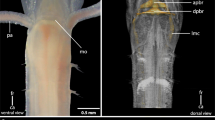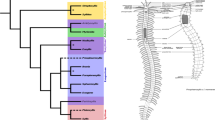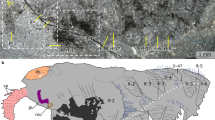Summary
The nature and homologues of the appendages of the anterior end of the polychaete families Sabellidae and Serpulidae have long been discussed. The main purpose of the present investigation, in which seven sabellid and eight serpulid species are studied, is to contribute towards the solution of these problems. At the same time, however, the present study, within its limited range, aims to enlarge our knowledge of the anatomy of the polychaetes in general. Such a knowledge, it is argued, is a prerequisite for further consideration of the phylogeny of the Polychaeta.
As shown in many earlier papers, the architecture of the cephalic nervous system and the innervation of the organs and appendages of the anterior end of polychaetes constitute reliable instruments for elucidating the morphological significance of these structures. In the present paper, consequently, extra consideration is given to descriptions of the central nervous system of the sabellids and serpulids studied.
The integumental depression found in front of and below the brain of all the sabellids and serpulids here studied is described by the term “dorsal pit”. It is concluded that the dorsal pit within each family in all probability represents a homologous structure, but it is in no way proven that the dorsal pit of the sabellids is equivalent to that of the serpulids.
Some earlier literature maintains that paired antennae [antennes de première paire in Binard and Jennerś (1928) terminology] are found in some sabellids and serpulids. In the present paper it is maintained that these structures must instead be interpreted as nuchal organs. Such organs are found in all the sabellid and serpulid species here studied.
The Pruvot-Meyer theory which claims that the joint pore of the thoracic nephridia of the “serpulimorphic” families is equivalent to the nuchal organ of other polychaetes is shown to be without foundation, and it is consequently rejected.
The histology, vascularization, and innervation of the branchial crown and the appendages of the dorsal lip of the mouth of the species investigated are described. It is concluded that the branchial crown and some (but not all) appendages of the dorsal lip are equivalent to the palps (when present) of the “spiomorphic”, the “drilomorphic”, and the “errant” polychaetes.
The appendages of the dorsal lip of the mouth, in most faunistic literature called palps, are found to represent structures of three different kinds and origins: (a) branchial radioli which have become separated from the crown and have fused with the lip, (b) branchial pinnulae which have undergone a similar process of dislocation, and (c) new formations from the walls of the mouth cavity. It is proposed that in comparative-anatomical works these appendages should be called (a) lip-associated radioli, (b) lip-associated pinnulae, and (c) outgrowths of the dorsal lip respectively. As a joint and anatomically neutral term to be used in faunas and descriptions of the outer morphology, the expression “appendages of the dorsal lip” or, more briefly, “(dorsal) lip processes” is proposed.
The interrelationships of the Sabellariidae, the Sabellidae, and the Serpulidae are discussed, as is the taxonomic subdivision of the last two families. In agreement with some earlier authors although contrary to others it is thereby maintained that:
-
1)
the suborder Serpulimorpha Hatschek (1893) (inclucing sabellariids, sabellids, and serpulids) does not constitute a natural systematic unit;
-
2)
the sabellids and serpulids, although markedly different in many respects (thoracic membrane, operculum, branchial skeleton), are probably closely related to each other. Earlier arguments supporting this view are corroborated by data on the dorsal lip processes and the architecture of the brain of the two families;
-
3)
Rioja's (1923) division (based on setal structures) of the Sabellidae into the three subfamilies Sabellinae, Fabriciinae, and Myxicolinae is supported by the anatomical data emphasized in the present paper; and
-
4)
within the Serpulidae the genera Apomatus and Protula should be referred to the subfamily Filograninae [as proposed by Rioja (1923), followed, among others, by Fauvel (1927), and Hartmann-Schröder (1971)] and not to the Serpulinae, [as maintained by Hartman (1959) and Fauchald (1977)]. Again, the view presented by the present author is founded on anatomical data (the morphological value of the dorsal lip processes of the genera in question).
Similar content being viewed by others
Abbreviations
- aac :
-
anterior association commissure
- acdrcc :
-
anterior coil of drcc
- apmcg :
-
anterior part of mcg
- astlap :
-
axis of supporting tissue of lap
- astlar :
-
axis of supporting tissue of lar
- astp :
-
axis of supporting tissue of pinnula
- astr :
-
axis of supporting tissue of radiolus
- ataac :
-
anterior tract of aac
- atdac :
-
anterior tract of dac
- atvac :
-
anterior tract of vac
- bfr :
-
basal fold of radiolus
- bgr :
-
basal groove of radiolus
- bvlap :
-
blood vessel of lap
- bvlar :
-
blood vessel of lar
- bvmdr :
-
blood vessel of the most dorsal radiolus
- bvp :
-
blood vessel of pinnula
- bvr :
-
blood vessel of radiolus
- bvrr :
-
blood vessels of radioli
- cc :
-
circum-oesophageal connective(s)
- cg :
-
cerebral ganglion
- cil :
-
cilia
- cnac :
-
commissure of nac and nmr
- cnof :
-
common nerve of oral filaments
- ctndbv :
-
curved tract of ndbv
- dac :
-
dorsal association commissure
- dcdr :
-
dorsal commissure of drcc
- dcvr :
-
dorsal commissure of vrcc
- dg :
-
dorsal ganglion
- dl :
-
dorsal lip
- dn :
-
dorsal nerve from dcdr
- dnno :
-
diffuse nervous lamina of nuchal organ
- dp :
-
dorsal pit
- drcc :
-
dorsal root of cc
- drnbc :
-
dorsal root of nbc
- gmnbc :
-
ganglion of mnbc
- lap :
-
lip-associated pinnula
- lar :
-
lip-associated radiolus
- lbv :
-
large branchial blood vessel
- lcg :
-
lateral cerebral ganglion
- lgndbv :
-
lateral ganglion of ndbv
- lgr :
-
lateral groove of radiolus
- lgvac :
-
lateral ganglion of vac
- llat :
-
left longitudinal association tract
- lnbc :
-
lateral nerve of branchial crown
- lnn :
-
lateral nuchal nerve
- lns 1 :
-
lateral nerve of segment 1
- lns 2 :
-
lateral nerve of segment 2
- lprndbv :
-
lateral posterior root of ndbv
- m :
-
mouth
- mcg :
-
median cerebral ganglion
- mgndbv :
-
median ganglion of ndbv
- mnbc :
-
median nerve of branchial crown
- mnn :
-
median nuchal nerve
- mprndbv :
-
median posterior root of ndbv
- nac :
-
nerve(s) of the alimentary canal
- nbc :
-
nerve of the branchial crown
- nc :
-
nerve of collar
- ndbv :
-
nerve of the dorsal blood vessel
- nlar :
-
nerve of lar
- nmdr :
-
nerve of the most dorsal radiolus
- nmr :
-
nerve(s) of the mouth region
- nn :
-
nuchal nerve
- nlap :
-
nerve of lip-associated pinnula
- nr :
-
nerve(s) of radiolus (-i)
- nvlm 1 nvlm 2 :
-
nerves to ventral longitudinal muscles
- odl :
-
outgrowths of the dorsal lip
- oes :
-
oesophagus
- pcdrcc :
-
posterior coil of drcc
- pnr 1 pnr 2 etc.:
-
first, second, etc., palp nerve root
- ptdac :
-
posterior tract of dac
- ptvac :
-
posterior tract of vac
- rlat :
-
right longitudinal association tract
- sstlar :
-
surrounding sheath of supporting tissue of lar
- sstr :
-
surrounding sheath of supporting tissues of radiolus
- stlar :
-
supporting tissue of lar
- stndbv :
-
sagittal tract of ndbv
- vac :
-
ventral association commissure
- vcdr :
-
ventral commissure of drcc
- vcvr :
-
ventral commissure of vrcc
- vg 1 :
-
first ventral ganglion
- vg 2 :
-
second ventral ganglion
- vg 3 :
-
third ventral ganglion
- vl :
-
ventral lip
- vrcc :
-
ventral root of cc
- vrnbc :
-
ventral root of nbc
- vs :
-
ventral sac
References
Åkesson B (1963) The comparative morphology and embryology of the head in scale worm (Aphroditidae, Polychaeta). Ark Zool 16, 7:125–163
Attems CG (1902) Beiträge zur Anatomie und Histologie von Scololepis fuliginosa Clap. Arb Zool Inst Univ Wien 14:173–210
Bailey-Brock JH, Knight-Jones P (1977) Spirorbidae (Polychaeta) collected by R.V. “Vitjas” from abyssal depths of the Pacific Ocean. J Zool London 181:315–321
Benham WB (1896) Archiannelida, Polychaeta and Myzostomaria. The Cambridge Natural History, Macmillan & Co, London, vol 2: 239–344
Bernert J (1926) Untersuchungen über das Zentralnervensystem der Hermione hystrix (L.M.). Z Morphol Ökol Tiere 6:743–810
Binard A, Jeener R (1928) Morphologie du lobe préoral des polychètes. Rec Inst Zool Torley-Rousseau 2:117–240
Bock S (1913) Zur Kenntnis von Nectonema und dessen systematischer Stellung. Zool Bidr Uppsala 2:1–30
Brunotti C (1888) Recherches anatomiques sur une espèce du genre Branchiomma. Trav Sta Zool Cette 2, 16:1–77
Claparède E (1873) Recherches sur la structure des Annélides sédentaires. Mém Soc Phys Genève 22:1–200
Clark RB (1969) Systematics and phylogeny: Annelida, Euchiura, Sipuncula. In: Florkin M, Scheer BT (eds) Chemical Zoology, Vol. 4. Academic Press, New York: pp 1–68
Dales RP (1962) The polychaete stomodeum and the inter-relationships of the families of Polychaeta. Proc Zool Soc London 139:389–428
Defretin R (1949) Recherches sur la musculature des Néréidiens au cours de l'épitoquie, les glandes parapodiales et la spermiogénèse. Ann Inst Océanogr Monaco sér 2, 24:117–257
Dehorne A (1908) Les néphridiens thoraciques des Hermellides. CR Acad Sci Paris 146:838–840
Dehorne A (1935) Caractères anatomiques et cytologiques des néphridies thoraciques de Sabellaria. CR Acad Sci Paris 200:1783–1785
Dehorne A (1952) Précisions sur le type anatomique des néphridies thoraciques des Sabellaridés. Arch Zool Exp Gén 89:37–49
Evenkamp H (1931) Morphologie, Histologie und Biologie der Sabellidenspecies Laonome Kroyeri Malmgr. und Euchone papillosa M. Sars. Zool Jahrb Abt Anat 53:405–534
Fauchald K (1977) The polychaete worms. Definitions and keys to the orders, families and genera. Natural History Museum of Los Angeles County, Science Series 28:1–190
Fauvel P (1927) Polychètes sédentaires. Addenda aux Errantes, Archiannélides, Myzostomaires. Faune Fr 16:1–494
Friedrich H (1938) Polychaeta. Tierwelt Nord- u. Ostsee, Lief. 32, Teil VI b, pp 1–201
Gustafson G (1930) Anatomische Studien über die Polychäten-Familien Amphinomidae und Euphrosynidae. Zool Bidr Uppsala 12:305–471
Hamaker JI (1898) The nervous system of Nereis virens Sars. A study in comparative neurology. Bull Mus Comp Zool Harv 32, 6:89–124
Hanson ED (1977) The Origin and Early Evolution of Animals. London, Pitman: p 1–670
Hanström B (1928) Weitere Beiträge zur Kenntnis des Gehirns und der Sinnesorgane der Polychäten (Polygordius, Tomopteris, Scolecolepis). Z Morphol Ökol Tiere 13:329–358
Hanström B (1930) Beitrag zur Diskussion des Kopflappens der Polychäten. Lunds Universitets Årsskr., N.F., Avd 2, 27:1–29
Hartman O (1959) Catalogue of the polychaetous annelids of the world. Allan Hancock Foundation Occasional paper 23:1–628
Hartmann-Schröder G (1971) Annelida, Borstenwürmer, Polychaeta. Tierwelt Dtl 58:1–594
Hatschek B (1893) System der Anneliden, ein vorläufiger Bericht. Lotos 13:123–126
Hempelmann F (1911) Zur Naturgeschichte von Nereis dumerilii Aud. et Edw. Zoologica, Stuttgart 25:1–135
Hempelmann F (1931) Erste und zweite Klasse der Vermes Polymera (Annelida). Archiannelida und Polychaeta. In: Kükenthal W, Krumbach T (eds) Handbuch der Zoologie, Bd. 2, Teil 2, Lief. 12 u. 13. de Gryter, Berlin Leipzig: pp 1–212
Holmgren N (1916) Zur vergleichenden Anatomie des Gehirns von Polychaeten, Onychophoren, Xiphosuren, Arachniden, Crustaceen, Myriapoden und Insekten. Vorstudien zu einer Phylogenie der Arthropoden. K Svenska VetenskAkad Handl 56:1–303
Johansson KE (1927) Beiträge zur Kenntnis der Polychaeten-Familien Hermellidae, Sabellidae und Serpulidae. Zool Bidr Uppsala 11:1–184
Knight-Jones Ph (1978) Spirorbidae (Polychaeta: Sedentaria) from the east Pacific, Atlantic and Southern Ocean. Zool J Linn Soc 64:201–240
Knight-Jones Ph, Fordy MR (1979) Setal structure, functions and interrelationships in Spirorbidae (Polychaeta, Sedentaria). Zool Scr 8:119–138
Knight-Jones Ph, Knight-Jones EW, Thorp CH, Gray PWG (1975a) Immigrant spirorbids (Polychaeta Sedentaria) on the Japanese Sargassum at Portsmouth, England. Zool Scr 4:145–149
Knight-Jones EW, Knight-Jones Ph, Al-Ogily SM (1975b) Ecological isolation in the Spirorbidae. Proc. 9th Europ Mar Biol Symp 1975, pp 539–561
Korn H (1958) Vergleichend-embryologische Untersuchungen an Harmothoe Kinberg, 1857 (Polychaeta, Annelida). Organogenese und Neurosekretion. Z Wiss Zool 161:345–443
Meyer E (1887) Studien über den Körperbau der Anneliden I-III. Mitt Zool Sta Neapel 7:592–741
Meyer E (1888) Studien über den Körperbau der Anneliden IV. Mitt Zool Sta Neapel 8:462–662
Nicol EAT (1931) The feeding mechanism, formation of the tube, and physiology of digestion in Sabella pavonina. Trans R Soc Edinburgh 56:537–598
Orrhage L (1962) Über das Vorkommen von Muskelzellen vom „Nematoden-Typus“ bei Polychaeten als phylogenetisch-systematisches Merkmal. Zool Bidr Uppsala 35:321–327
Orrhage L (1964a) Anatomische und morphologische Studien über die Polychaetenfamilien Spionidae, Disomidae und Poecilochaetidae. Zool Bidr Uppsala 36:335–405
Orrhage L (1964b) Beiträge zur Kenntnis der spiomorphen Polychaeten. Acta Univ Upsaliensis Abstr Upps Diss Sci 50:1–16
Orrhage L (1966) Über die Anatomie des zentralen Nervensystemes der sedentären Polychaeten. Ein Beitrag zur Diskussion über die Architectur des Polychaeten-Gehirns und über den Begriff Palpen bei den Borstenwürmern. Ark Zool Stockholm, Ser 2, 19:99–133
Orrhage L (1974) Über die Anatomie, Histologie und Verwandtschaft der Apistobranchidae (Polychaeta Sedentaria) nebst Bemerkungen über die systematische Stellung der Archianneliden. Z Morphol Tiere 79:1–45
Orrhage L (1978) On the structure and evolution of the anterior end of the Sabellariidae (Polychaeta Sedentaria). With some remarks on the general organisation of the polychaete brain. Zool Jahrb Abt Anat 100:343–374
Pillai TG (1960) Some marine and brackish-water Serpulid Polychaeta from Ceylon, including new genera and species. Ceylon J Sci Biol Sci 3:1–40
Pillai TG (1970) Studies on a collection of spirorbids from Ceylon, together with a critical review and revision of spirorbid systematics, and an account of their phylogeny and zoogeography. Ceylon J Sci Biol Sci 8:100–172
Prenant A (1929) Recherches sur la structure des muscles des Annélides polychètes et sur leur sarcolyse. Arch Zool Exp Gén 69:1–135
Pruvot G (1885) Recherches anatomiques et morphologiques sur le système nerveux des Annélides Polychètes. Arch Zool Exp Gén Sér 2, 3:211–336
Quatrefages MA de (1850) Études sur les types inférieurs de l'embranchement des Annelés. Mémoire sur le système nerveux des Annélides. Annls Sci Nat, Sér 3, 14:329–398
Racovitza E-G (1896) Le lobe céphalique et l'encéphale des Annélides Polychètes (Anatomie, Morphologie, Histologie). Arch Zool Exp Gén, Sér. 3, 4:133–343
Remane A (1956) Die Grundlagen des natürlichen Systems, der vergleichenden Anatomie und der Phylogenetik. Leipzig. Akademische Verlagsgesellschaft: pp 1–364
Retzius G (1895) Zur Kenntnis des Gehirnganglions und des sensiblen Nervensystems der Polychaeten. Biol Untersuch 7:2–3
Rioja E (1923) Estudio sistemático de las especies ibéricas del suborden Sabelliformia. Trab Mus Nac Cienc Nat Madrid, Ser Zool 48:3–144
Rohde E (1885) Die Musculatur der Chaetopoden. Zool Beitr Berlin 1:164–205
Romieu M (1923) Contribution a l'histologie comparée du muscle strié. C R Acad Sci Paris 176:864–867
Rullier F (1951) Etude morphologique, histologique et physiologique de l'organe nucal chez les Annélides polychètes sédentaires. Ann Inst Océanogr Monaco 25:207–341
Salensky W (1907) Morphologische Studien an Würmern. II-IV.Mém Acad Sci St.-Pétersburg (Sci Math Phys Nat) Sér 8, 19:1–349
Söderström A (1920) Studien über die Polychätenfamilie Spionidae. Almqvist & Wiksell, Uppsala: Diss: pp 1–286
Strelzov VE (1979) Polychaete Worms of the Family Paraonidae Cerruti, 1909 (Polychaeta, Sedentaria) Translated from Russian. Nauka Publishers, Leningrad branch, Leningrad 1973. Amerind Publ. Co, New Delhi: pp 1–212
Uchida H (1978) Serpulid tube worms (Polychaeta, Sedentaria) from Japan with the systematic review of the group. Bull Marine Park Res St 2:1–98
Ushakov PV (1955) The Polychaeta of the Far-eastern Seas of the USSR (in Russian) Opred po faune SSSR 56:1–445
Viallanes MH (1886) Sur la structure du squelette branchial de la Sabelle. Annls Sci Nat, Sér 6,20:1–20
Author information
Authors and Affiliations
Rights and permissions
About this article
Cite this article
Orrhage, L. On the structure and homologues of the anterior end of the polychaete families sabellidae and serpulidae. Zoomorphology 96, 113–167 (1980). https://doi.org/10.1007/BF00310081
Received:
Issue Date:
DOI: https://doi.org/10.1007/BF00310081




